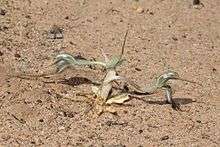Pterostylis despectans
Pterostylis despectans, commonly known as the lowly rustyhood, is a plant in the orchid family Orchidaceae and is endemic to south-eastern Australia. It has a rosette of leaves at its base and up to six flowers on long stalks, branching off a short flowering stem. The flowers have an insect-like labellum and often touch the ground.
| Lowly rustyhood | |
|---|---|
 | |
| Pterostylis despectans growing near Inglewood in Victoria | |
| Scientific classification | |
| Kingdom: | Plantae |
| Clade: | Tracheophytes |
| Clade: | Angiosperms |
| Clade: | Monocots |
| Order: | Asparagales |
| Family: | Orchidaceae |
| Subfamily: | Orchidoideae |
| Tribe: | Cranichideae |
| Genus: | Pterostylis |
| Species: | P. despectans |
| Binomial name | |
| Pterostylis despectans | |
| Synonyms[1] | |
| |
Description
Pterostylis despectans, is a terrestrial, perennial, deciduous, herb with an underground tuber. It has a rosette of between six and ten leaves at the base of the flowering spike, each leaf 10–20 mm (0.4–0.8 in) long and 6–8 mm (0.2–0.3 in) wide. The leaves are often withered by the time of flowering. Up to six translucent flowers with green and brown markings and 30–38 mm (1.2–1.5 in) long, 6–8 mm (0.2–0.3 in) wide are borne on a flowering spike 30–50 mm (1–2 in) tall. Each flower is carried on the end of a long, thin stalk. Three or four papery bracts are wrapped around the flowering spike. The dorsal sepal and petals are joined to form a hood called the "galea" over the column with the dorsal sepal having a thread-like tip 10–13 mm (0.4–0.5 in) long. The lateral sepals are slightly wider than the galea and often touch the ground. They are shallowly dished, densely hairy on their outer edges and suddenly taper to a thread-like tip, 20–26 mm (0.8–1 in). The labellum is brown to green, thin and insect-like, about 5 mm (0.2 in) long and 2 mm (0.08 in) wide. The "head" end has two long bristles and there are up to 10 to 16 shorter bristles on the side. Flowering occurs from November to December.[2][3][4][5]
Taxonomy and naming
The lowly greenhood was first formally described in 1950 by William Nicholls who gave it the name Pterostylis rufa var. despectans and published the description in The Victorian Naturalist. The type specimen was collected near Maryborough in Victoria.[6][7] In 1989, Mark Clements and David Jones raised it to species status.[1][8]
Distribution and habitat
Pterostylis despectans has a restricted distribution in each of the three Australian states in which it occurs. In New South Wales there is only a single population growing in grassland near Moama in the Riverina district. In Victoria it grows in forest near Maryborough, grassland near Bendigo and woodland near Horsham and in South Australia in parts of the Northern Lofty flora region.[2][3][4][5]
Conservation
Pterostylis despectans is classified as "endangered" under the Victorian Government Flora and Fauna Guarantee Act 1988, "critically endangered" in New South Wales, "endangered" in South Australia and as "endangered" (EN) under the Australian Government Environment Protection and Biodiversity Conservation Act 1999 (EPBC Act).[3][4][5][9] The main threats to this species are habitat loss and fragmentation, invasive species and low reproduction rates.[4]
References
- "Pterostylis despectans". APNI. Retrieved 12 May 2017.
- Jones, David L. (2006). A complete guide to native orchids of Australia including the island territories. Frenchs Forest, N.S.W.: New Holland. p. 326. ISBN 978-1877069123.
- Jeanes, Jeff. "Pterostylis despectans". Royal Botanic Gardens Victoria: vicflora. Retrieved 12 May 2017.
- "Conservation advice Pterostylis despectans" (PDF). Australian Government Department of the Environment. Retrieved 12 May 2017.
- "Pterostylis despectans - profile". New South Wales Government Office of the Environment and Heritage. Retrieved 12 May 2017.
- "Pterostylis rufa var. despectans". APNI. Retrieved 12 May 2017.
- Nicholls, William Henry (1950). "Contributions to the Orchidaceae of Australia - 1". The Victorian Naturalist. 66 (11): 215. Retrieved 12 May 2017.
- Clements, Mark Alwin (1989). "Catalogue of Australian Orchidaceae". Australian Orchid Research. 1: 122.
- "Census ofSouth Australian Plants - Pterostylis". State Herbarium of South Australia. Retrieved 12 May 2017.
